Evaluation of Pressure Resonance Phenomena in DCT Actuation Circuits
Abstract
1. Introduction
2. Materials and Methods
2.1. Steady State Model
2.2. 0D/1D Model for Dynamics Analysis
2.3. 0D/1D Model for Linear Analysis
2.4. Fluid Properties
2.5. Simulated Cases
3. Results
3.1. Steady State Model
3.2. Dynamic Analysis of the 0D/1D Models
3.2.1. Base Circuit
3.2.2. Modified Circuits
3.3. Linear Analysis of the 0D/1D Models
3.4. Fluid Sensitivity
4. Conclusions
Author Contributions
Funding
Institutional Review Board Statement
Informed Consent Statement
Data Availability Statement
Conflicts of Interest
Nomenclature
| β | Bulk Modulus |
| λ | Wavelength |
| ρ | Density |
| c | Celerity |
| AN | Helmholtz resonator neck cross sectional area |
| ATF | Automatic transmission fluid |
| CFD | Computational Fluid Dynamics |
| Cf | Friction Source |
| Cg | Gravity source |
| dN | Helmholtz resonator neck’s diameter |
| (L/d)x | Length/diameter of the pipe x; x = [1, 7] |
| DCT | Dual-Clutch Transmission |
| ECO | Eco-friendly oil |
| f | Frequency |
| L | Pipeline length |
| LN | Helmholtz resonator neck length |
| LCH | Resonance length |
| LP | Low Pressure |
| LPV C1 | Length from the pump to the PV of clutch 1 |
| LPV C2 | Length from the pump to the PV of clutch 2 |
| n | Pump order |
| nPump | Pump speed rate |
| p | Absolute pressure |
| p* | PRV cracking pressure |
| PRV | Pressure Regulation Valve |
| ps | System pressure |
| PV | Proportional Valve |
| PVs | Proportional Valves |
| S | Cross-sectional area |
| u | Velocity |
| VC | Helmholtz resonator volume |
| Vx | Volume of the pipe x; x = [1, 7] |
| z1 | Teeth of the Gerotor external gear |
| z2 | Teeth of the Gerotor internal gear |
| 1D | One-dimensional |
References
- Zhou, C.; Zhang, Z.; Liu, F.; Wang, W. Sensitivity analysis for probabilistic anti-resonance design of aeronautical hydraulic pipelines. Chin. J. Aeronaut. 2018, 32, 948–953. [Google Scholar] [CrossRef]
- Buono, D.; Schiano di Cola, F.D.; Senatore, A.; Frosina, E.; Buccilli, G.; Harrison, J. Modelling approach on a Gerotor pump working in cavitation conditions. Energy Procedia 2016, 101, 701–709. [Google Scholar] [CrossRef]
- Milani, M.; Montorsi, L.; Terzi, S.; Storchi, G. Analysis of a Double Inlet Gerotor Pump: A Dynamic Multi-phase CFD Approach Accounting for the Fluid Compressibility and Temperature Dependent Properties. In Proceedings of the International Mechanical Engineering Congress and Exposition, IMECE 2019, Salt Lake City, UT, USA, 11–14 November 2019. [Google Scholar] [CrossRef]
- Yulong, L.; Xingzhong, L.; Weipeng, L.; Hanyong. Hydraulic System Optimization and Dynamic Characteristic Simulation of Double Clutch Transmission. ESIAT 2011, 10, 1065–1070. [Google Scholar] [CrossRef][Green Version]
- Henclik, S. Numerical modeling of water hammer with fluid–structure interaction in a pipeline with viscoelastic supports. J. Fluids Struct. 2018, 76, 469–487. [Google Scholar] [CrossRef]
- Rouabeh, K.; Schmitt, C.; Elaoud, S.; Hadj-Taïeb, E.; Pluvinage, G. Failure of grey cast iron water pipe due to resonance phenomenon. Eng. Fail. Anal. 2012, 26, 120–128. [Google Scholar] [CrossRef]
- Guan, C.; Jiao, Z. Modeling and optimal design of 3 Degrees of freedom Helmholtz resonator in hydraulic system. Chin. J. Aeronaut. 2012, 25, 776–783. [Google Scholar] [CrossRef]
- Liśkiewicz, G.; Horodko, L.; Stickland, M.; Kryłłowicz, W. Identification of phenomena preceding blower surge by means of pressure spectral maps. Exp. Therm. Fluid Sci. 2014, 54, 267–278. [Google Scholar] [CrossRef]
- Fyfe, K.R.; Munck, E.D.S. Analysis of computed order tracking. Mech. Syst. Signal Process. 1997, 11, 187–205. [Google Scholar] [CrossRef]
- Mikota, G.; Manhartsgruber, B.; Kogler, H.; Hammerle, F. Modal testing of hydraulic pipeline systems. J. Sound Vib. 2017, 409, 256–273. [Google Scholar] [CrossRef]
- Gajrani, K.K.; Sankar, M.R. Past and current status of eco-friendly vegetable oil based metal cutting fluids. Mater. Today Proc. 2016, 4, 3786–3795. [Google Scholar] [CrossRef]
- Stryczek, J. Fundamentals of Designing Hydraulic Gear Machines; Wydawnictwo Naukowe PWN: Warsaw, Poland, 2020; ISBN 8301212268. [Google Scholar]
- Simcenter PLM Software, Amesim User Guide; Siemens PLM Software: Plano, TX, USA, 2020.

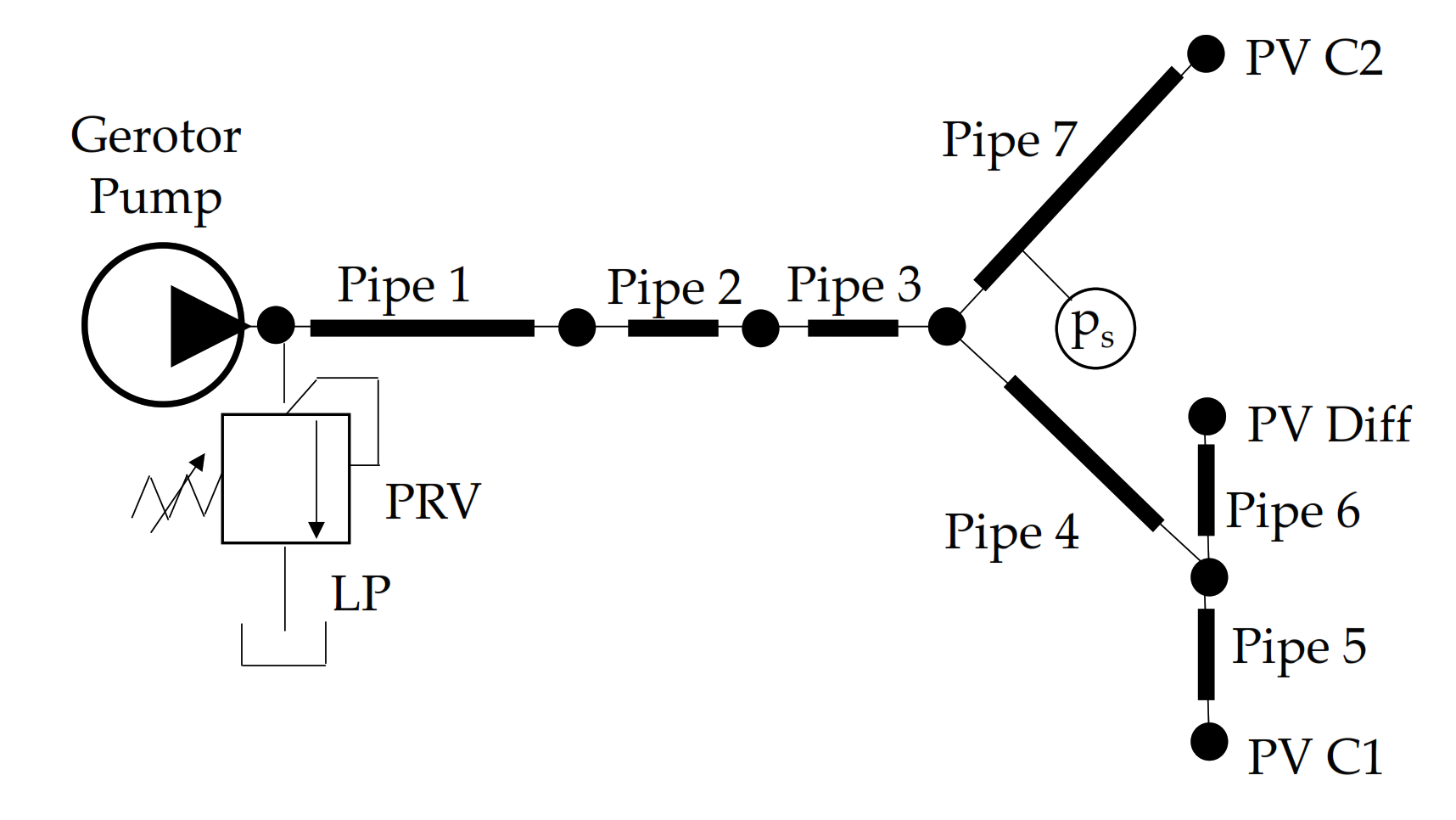
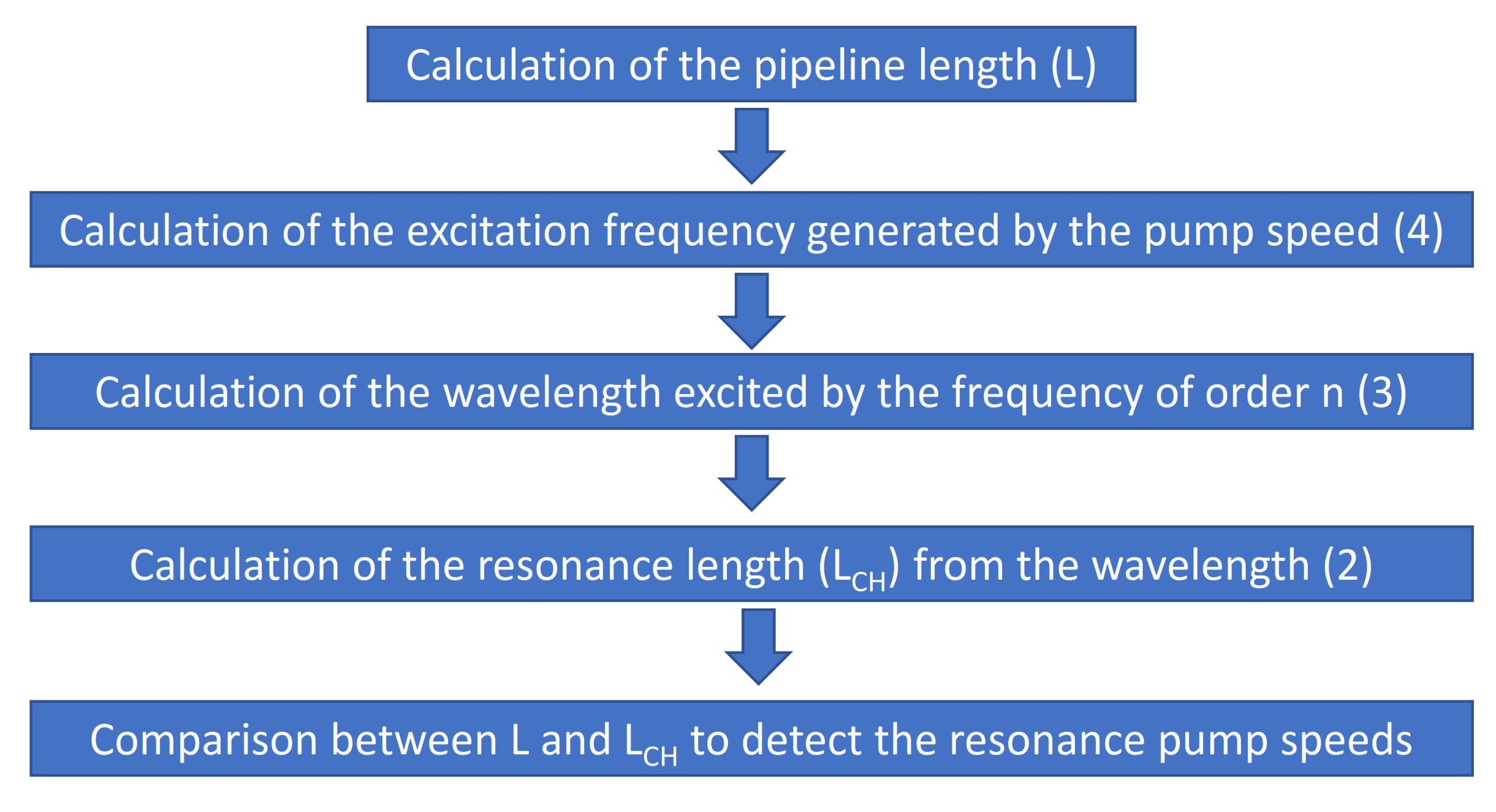

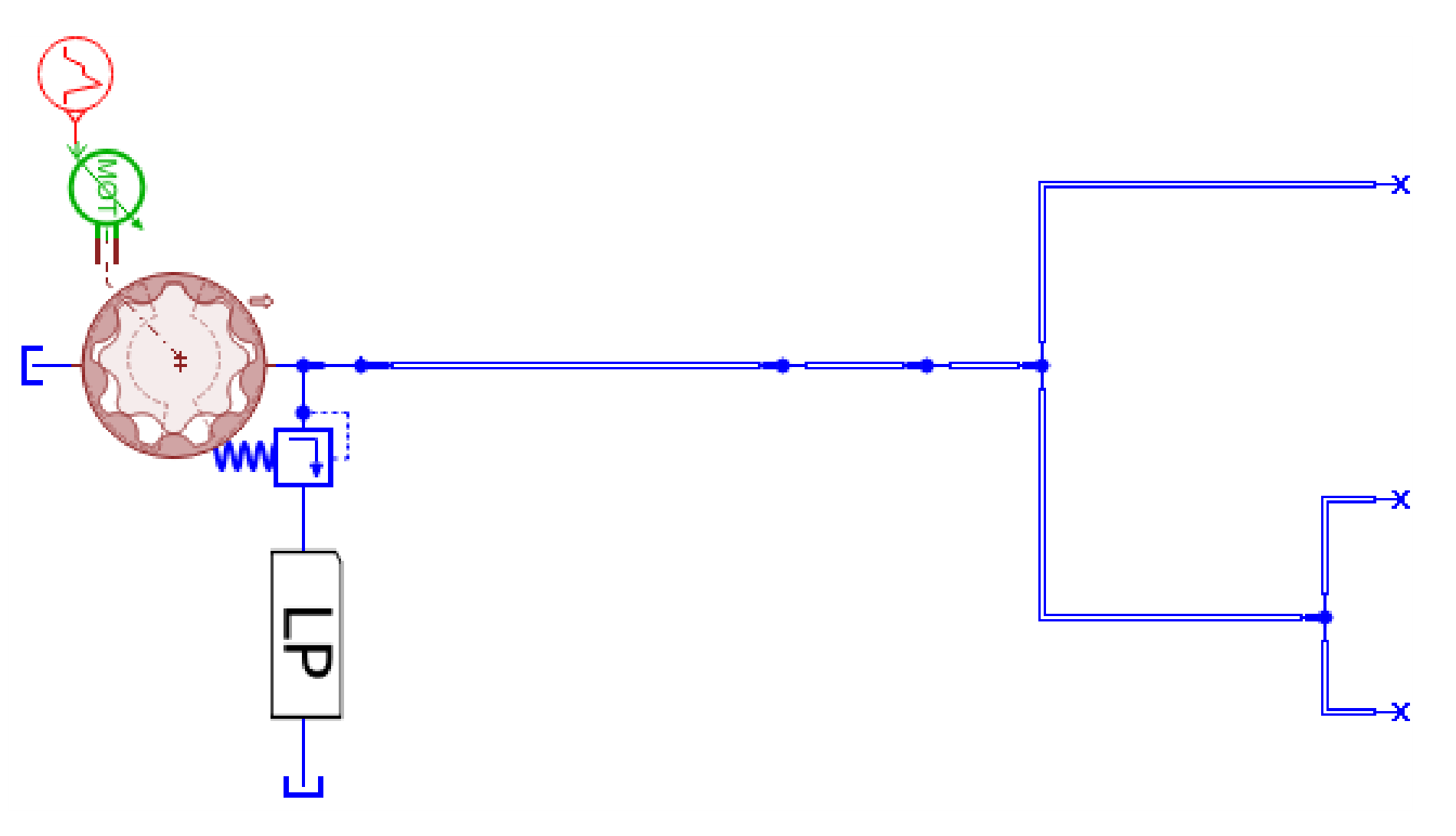
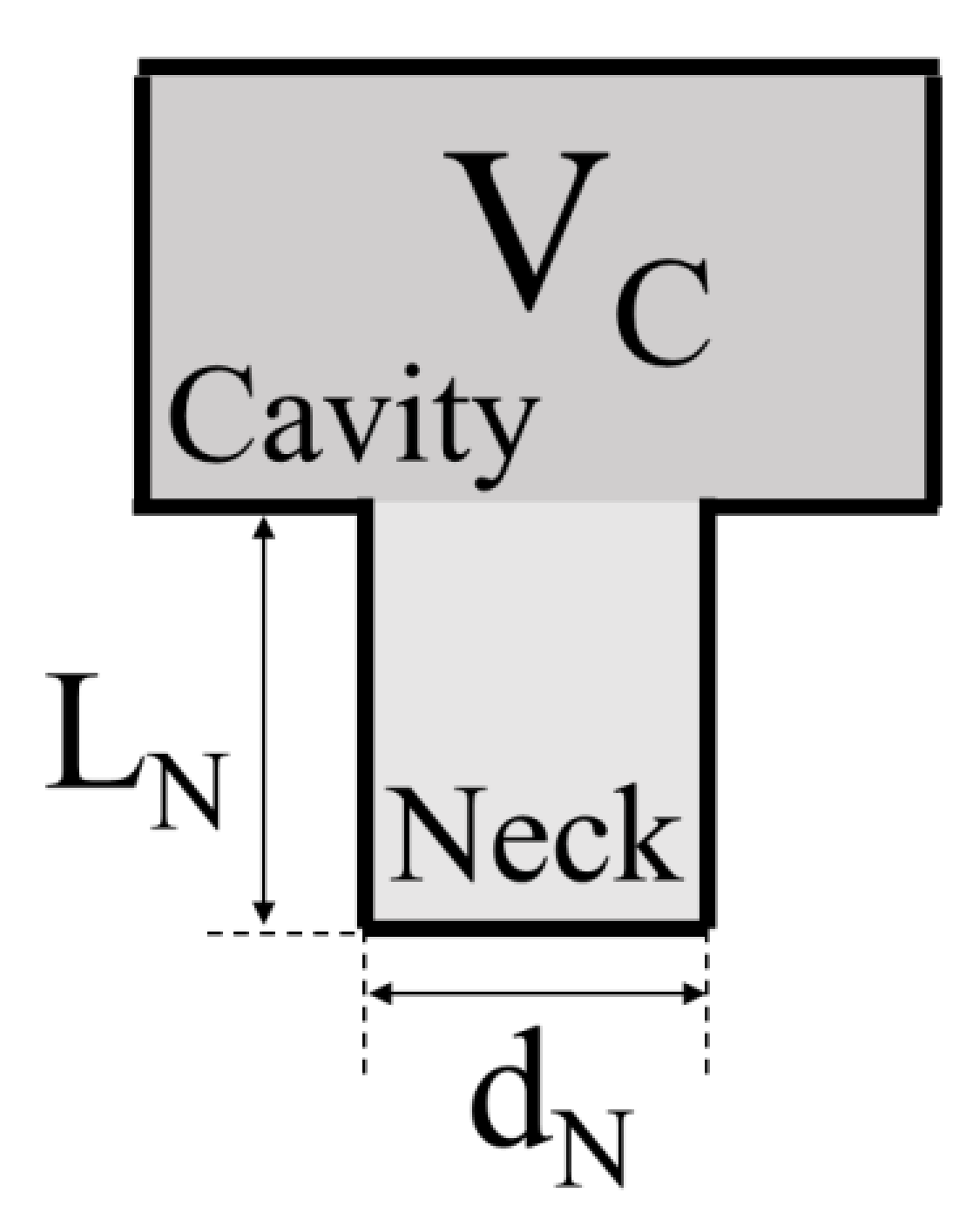
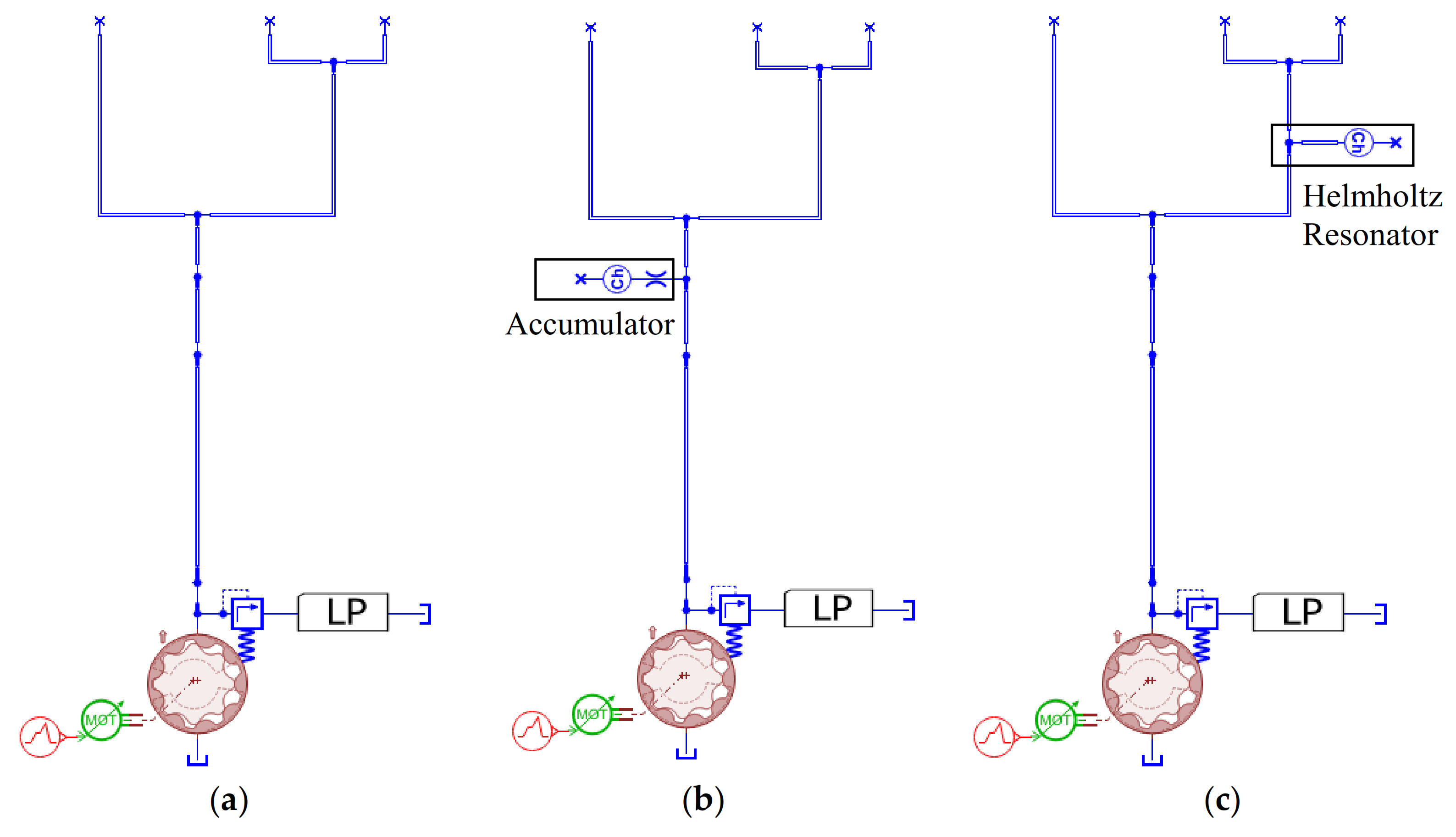


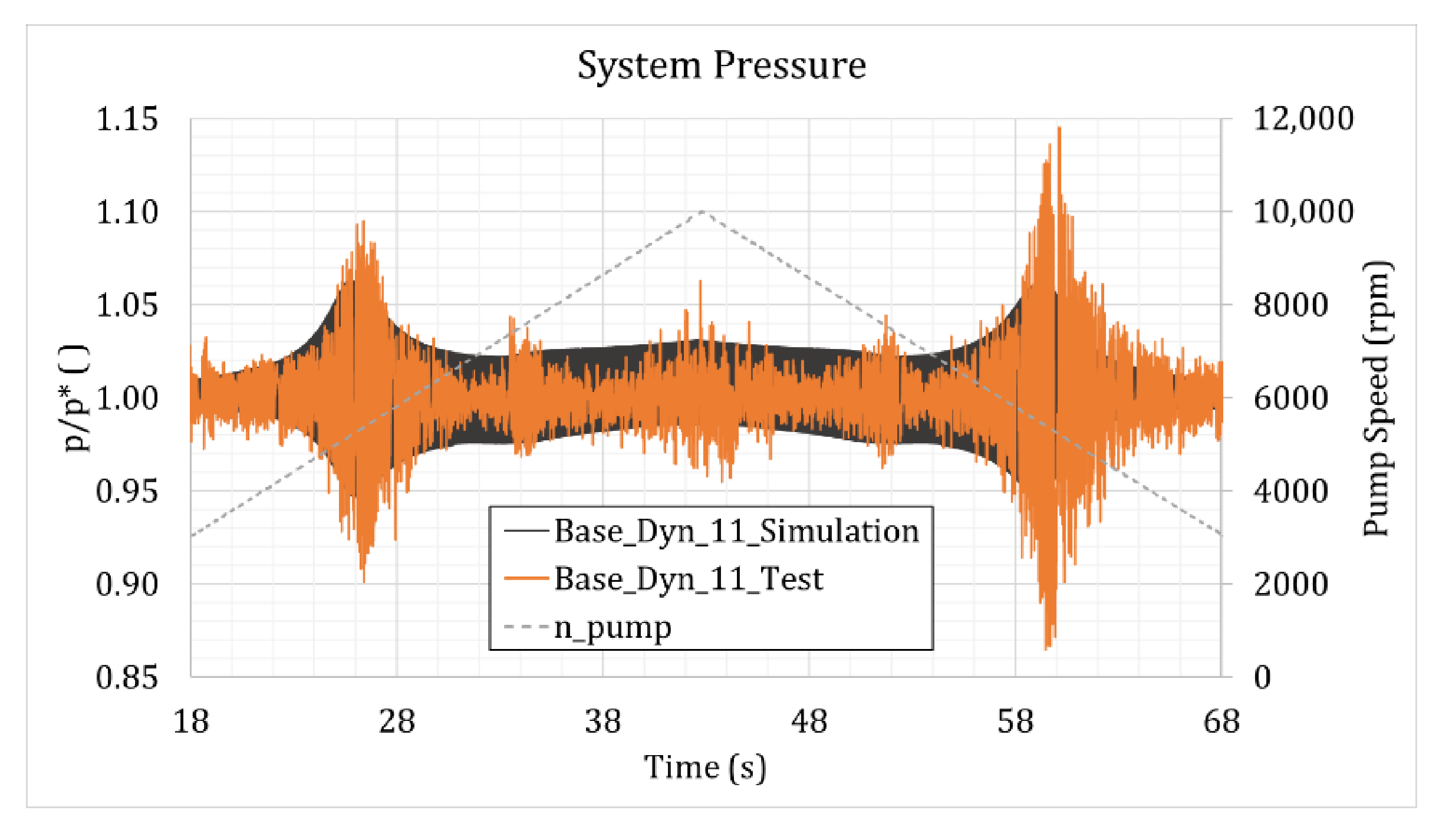
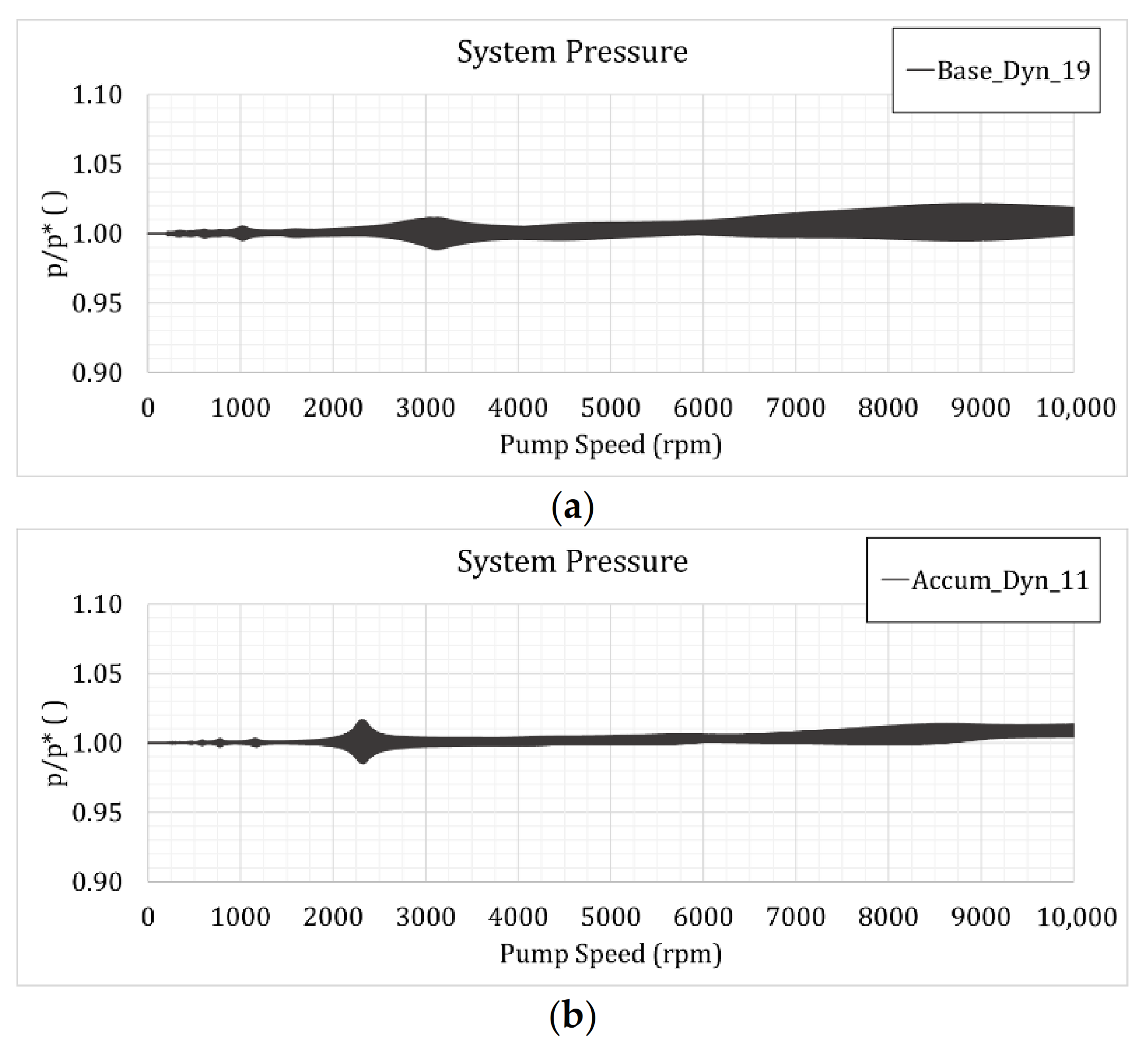
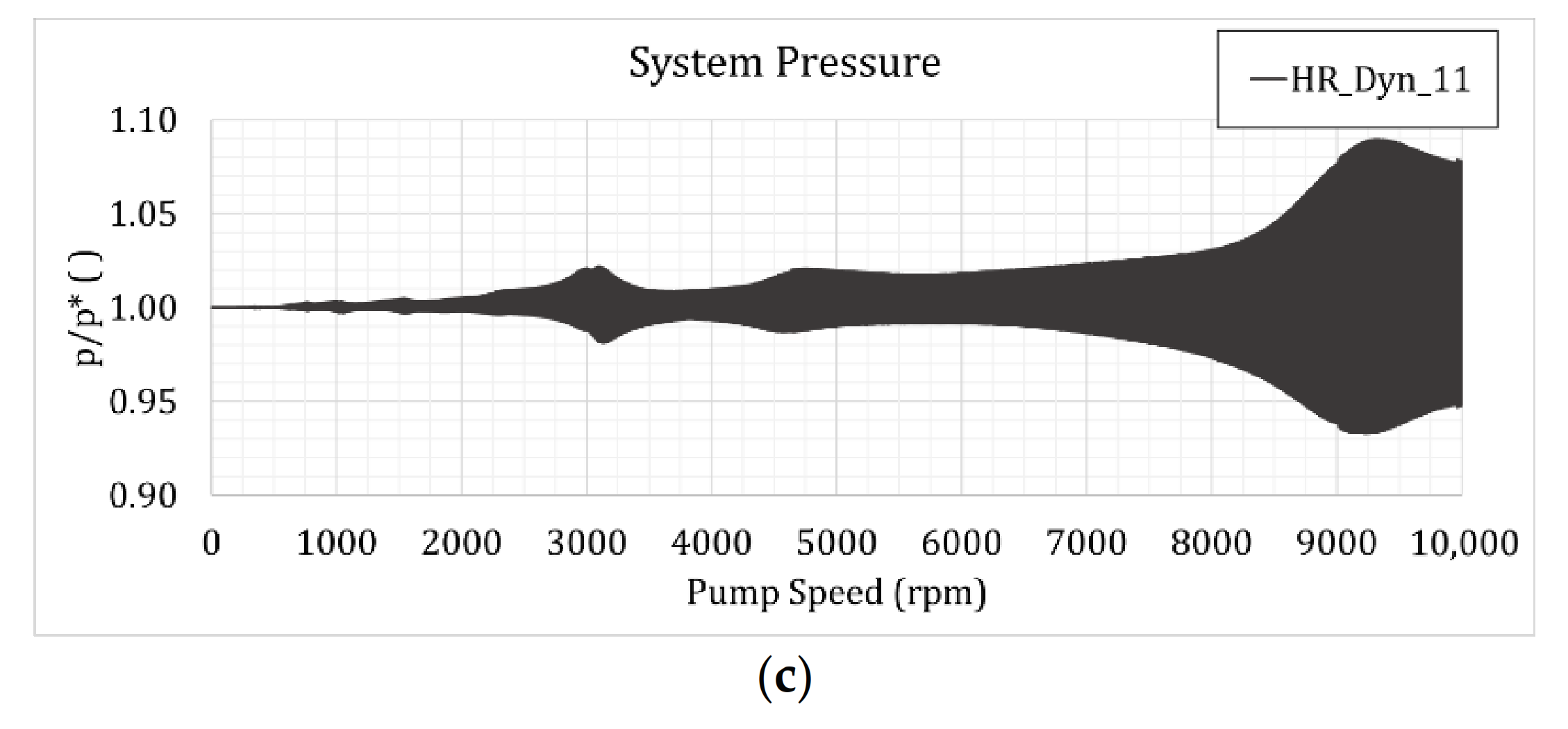
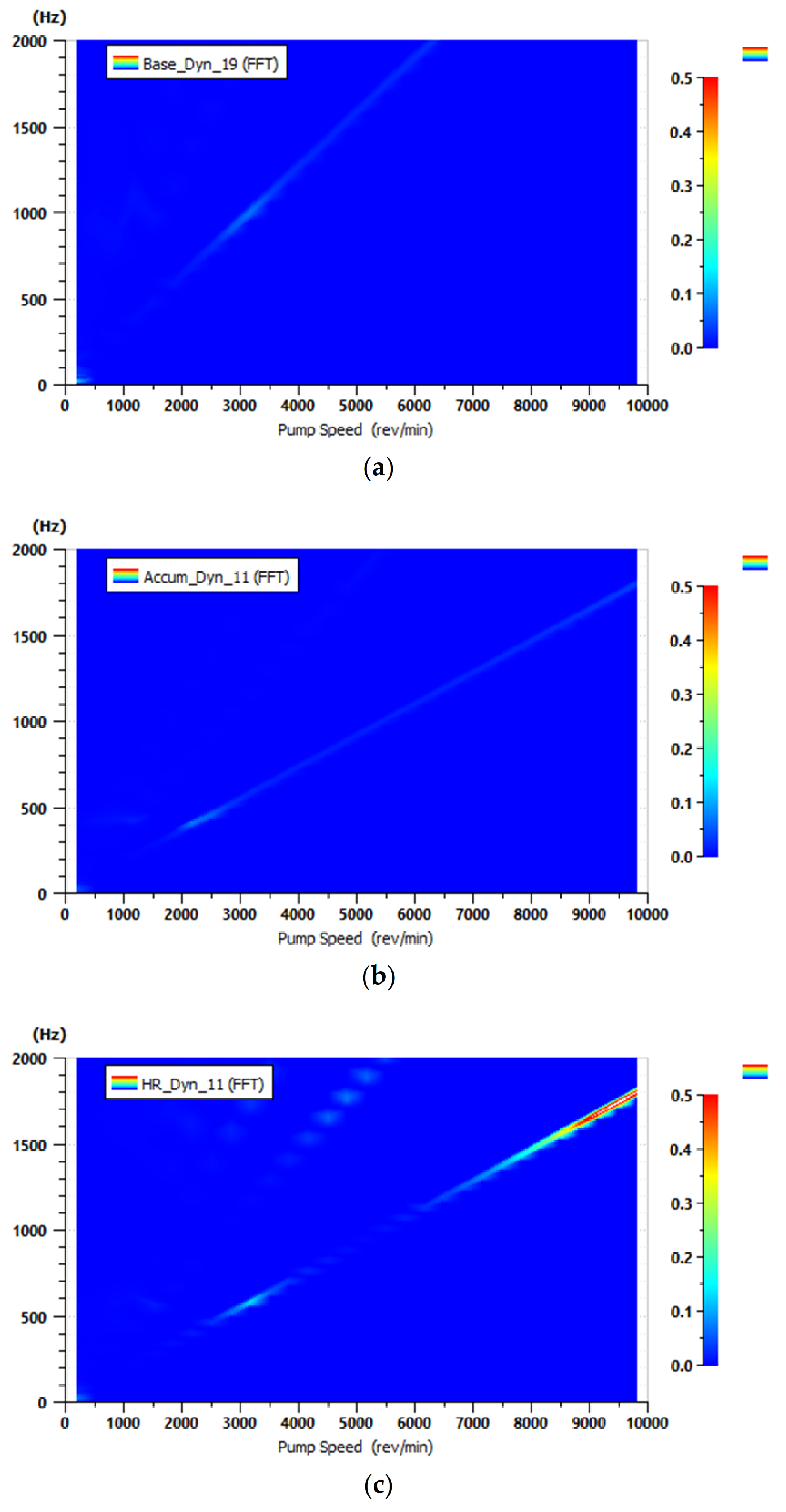
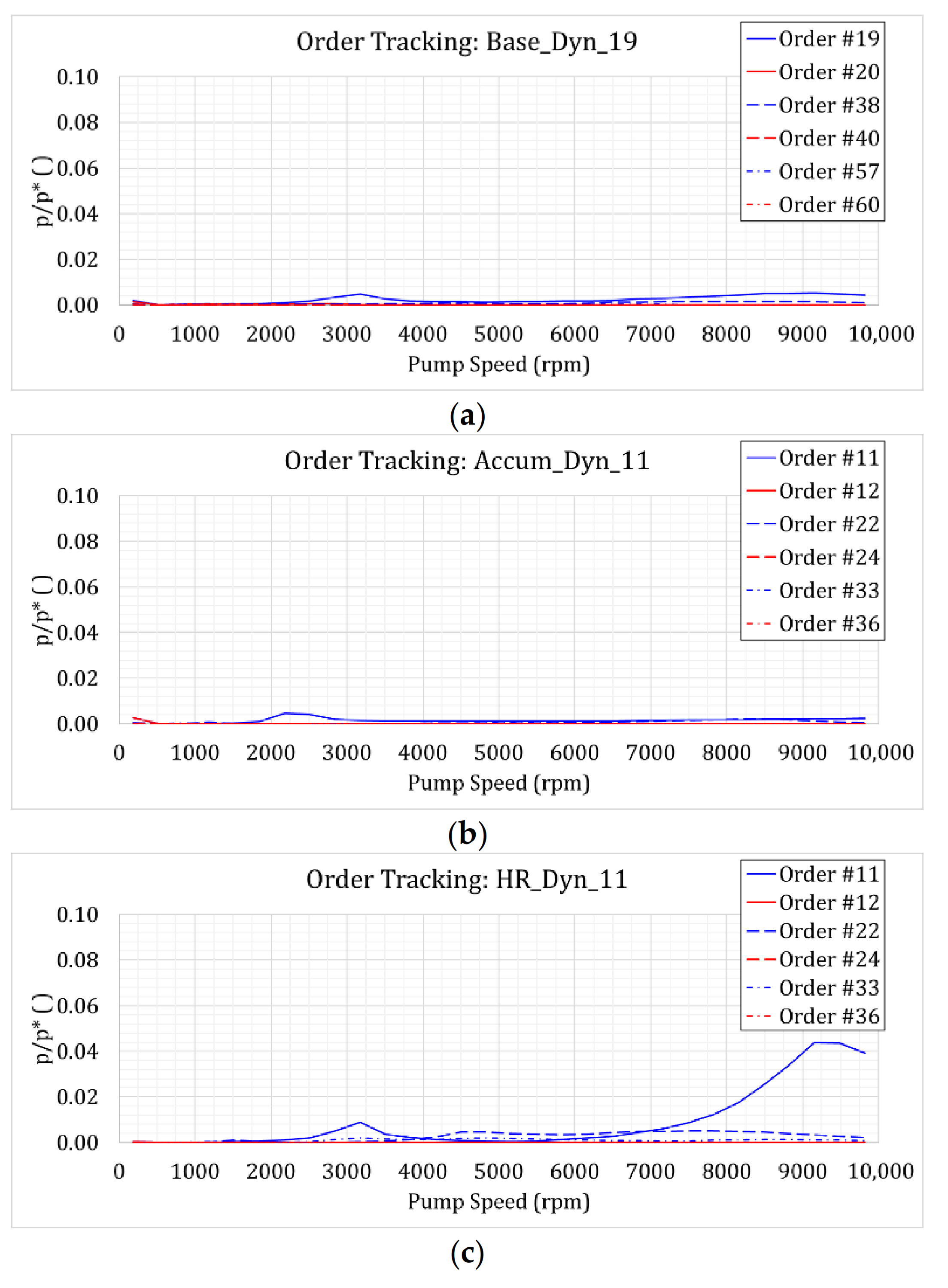
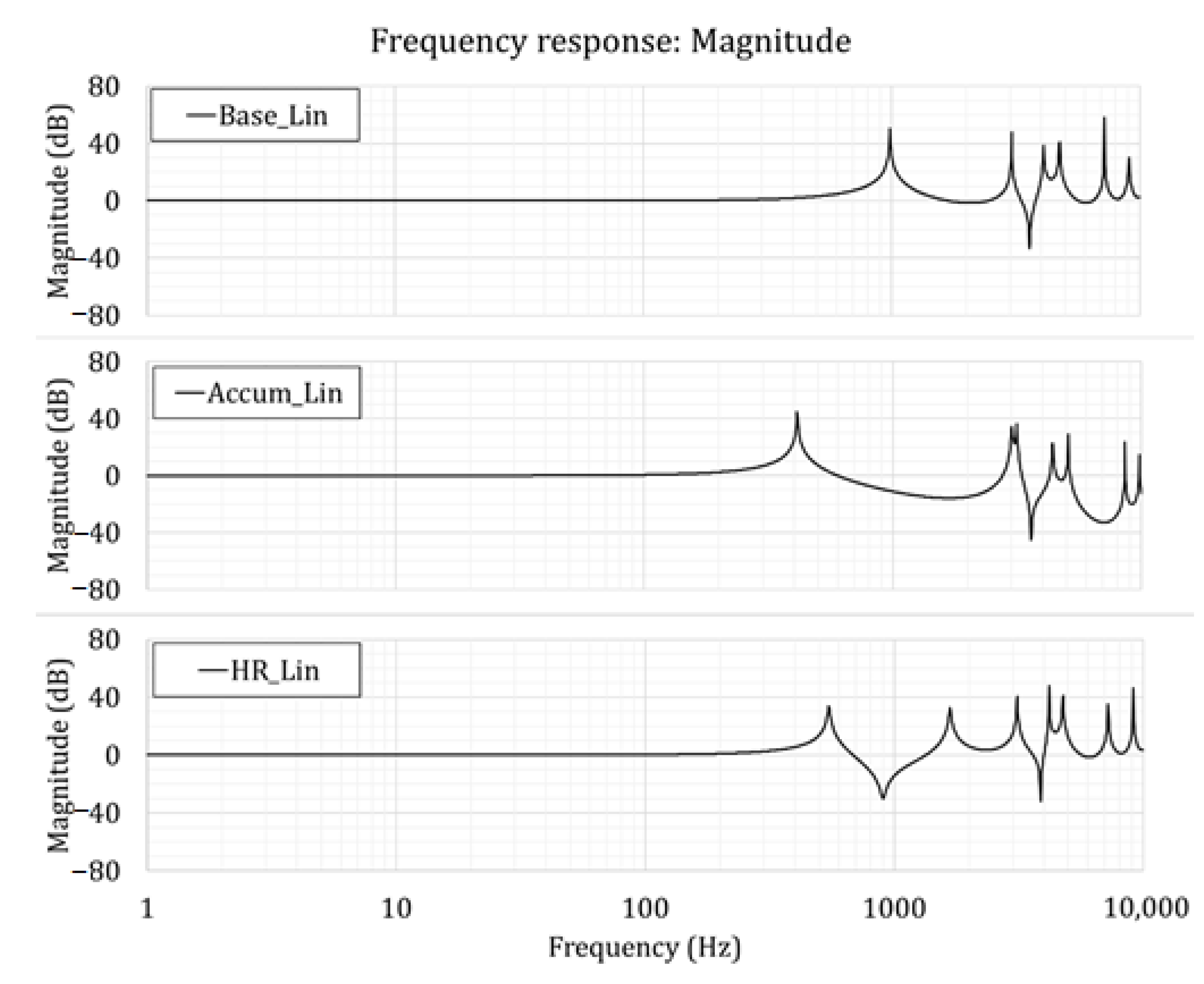
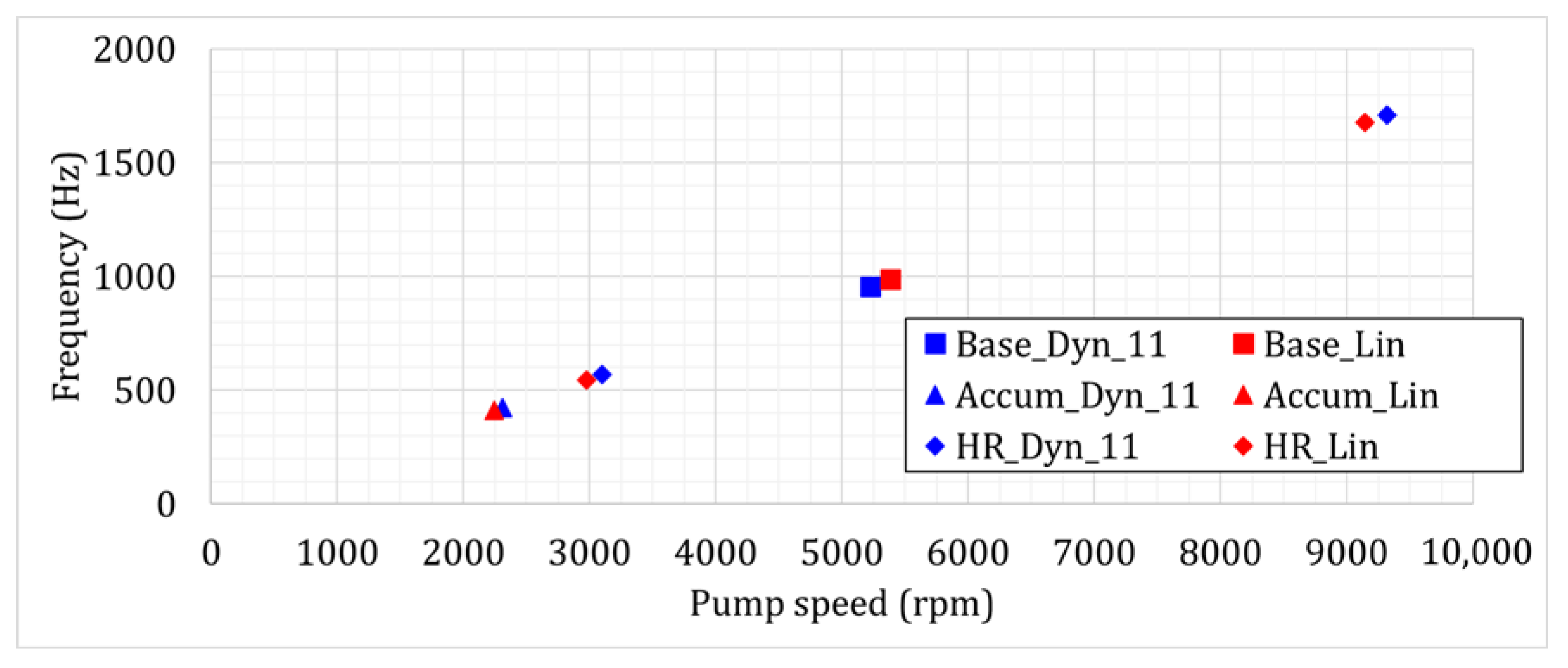
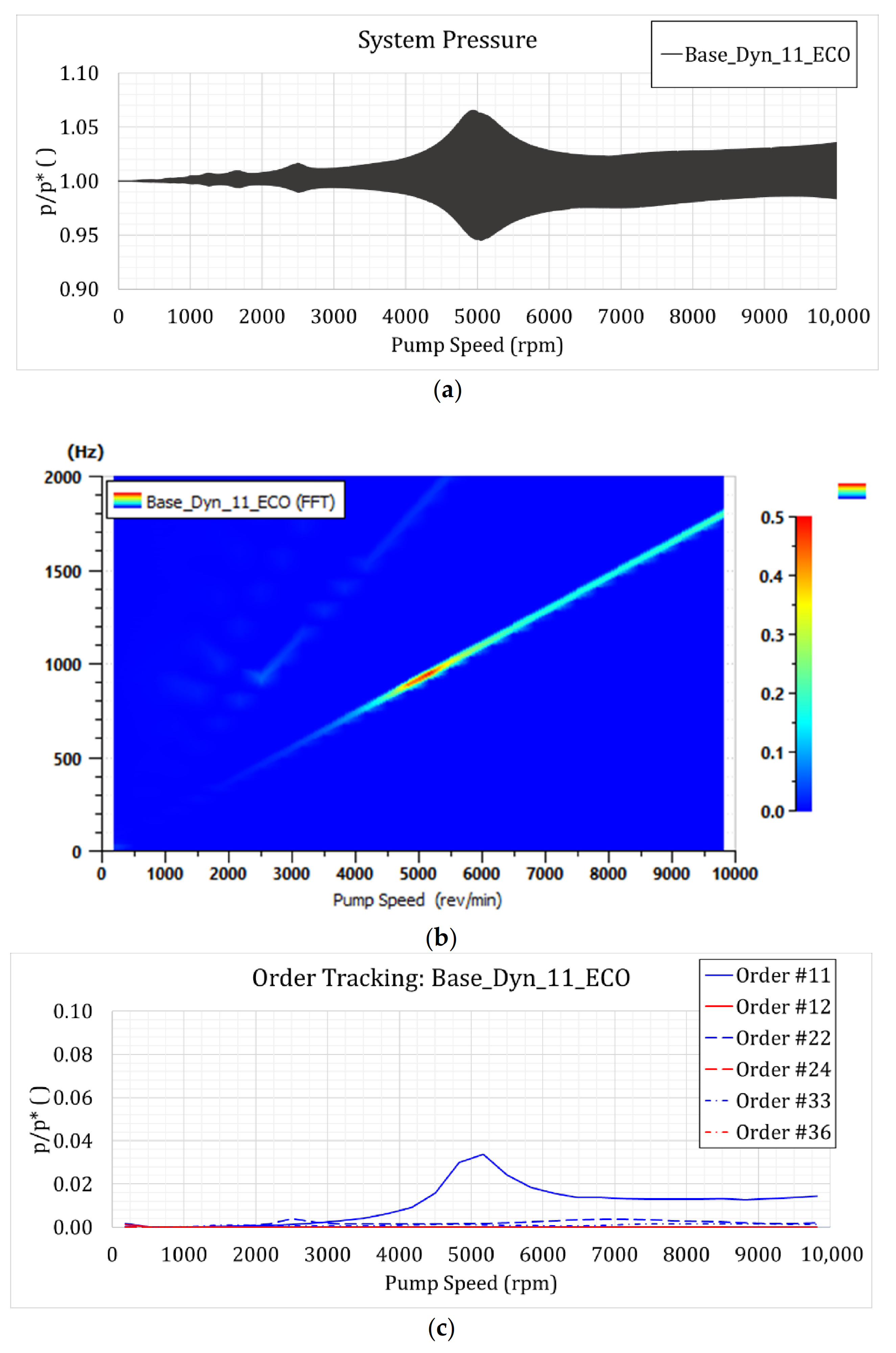
| Component | Parameters |
|---|---|
| Gerotor Pump | z1 = 12 teeth z2 = 11 teeth |
| Pipe 1 | (L/d)1 = 5.0; V1 = 22.90 cc |
| Pipe 2 | (L/d)2 = 14.0; V2 = 10.99 cc |
| Pipe 3 | (L/d)3 = 1.5; V3 = 1.18 cc |
| Pipe 4 | (L/d)4 = 6.0; V4 = 4.71 cc |
| Pipe 5 | (L/d)5 = 1.5; V1 = 1.18 cc |
| Pipe 6 | (L/d)6 = 1.5; V1 = 1.18 cc |
| Pipe 7 | (L/d)7 = 6.5; V1 = 5.11 cc |
| PV | Closed |
| PRV | p* |
| Parameter | Value |
|---|---|
| Vc | 27 cm3 |
| LN | 1.5 mm |
| DN | 1.1 mm |
| f | 1100 Hz |
| Fluid () | β (MPa) | ρ (kg/m3) | ν (cSt) |
|---|---|---|---|
| ATF | 1350 | 780 | 7.9 |
| ECO | 1350 | 873 | 11.4 |
| Case | Simulation Name | Analysis | z2 | Accumulator | Helmholtz Resonator | Fluid |
|---|---|---|---|---|---|---|
| #1 | Base_Dyn_11 | Dynamic | 11 | No | No | ATF |
| #2 | Base_Dyn_19 | Dynamic | 19 | No | No | ATF |
| #3 | Accum_Dyn_11 | Dynamic | 11 | Yes | No | ATF |
| #4 | HR_Dyn_11 | Dynamic | 11 | No | Yes | ATF |
| #5 | Base_Lin | Linear | 11 | No | No | ATF |
| #6 | Accum_Lin | Linear | 11 | Yes | No | ATF |
| #7 | HR_Lin | Linear | 11 | No | Yes | ATF |
| #8 | Base_Dyn_11_ECO | Dynamic | 11 | No | No | ECO |
| Steady State Model | |||||||||||||
|---|---|---|---|---|---|---|---|---|---|---|---|---|---|
| Pump Speed = nPump (rpm) | |||||||||||||
| 1000 | 2000 | 3000 | 4000 | 5000 | 5250 | 5500 | 5750 | 6000 | 7000 | 8000 | 9000 | 10,000 | |
| Frequency = f (Hz) | |||||||||||||
| 183 | 367 | 550 | 733 | 917 | 963 | 1008 | 1054 | 1100 | 1283 | 1467 | 1650 | 1833 | |
| Order | Wavelength = λ(mm) | ||||||||||||
| 1 | 7144 | 3572 | 2381 | 1786 | 1429 | 1361 | 1299 | 1242 | 1191 | 1021 | 893 | 794 | 714 |
| Resonance Length = LCH (mm) | |||||||||||||
| 1 | 1786 | 893 | 595 | 446 | 357 | 340 | 325 | 311 | 298 | 255 | 223 | 198 | 179 |
| Simulation | Pump Speed (rpm) | f (Hz) |
|---|---|---|
| Base_Dyn_11 | 5220 | 957 |
| Base_Dyn_19 | 3130 | 991 |
| Accum_Dyn_11 | 2310 | 423 |
| HR_Dyn_11 | 3100 9320 | 568 1708 |
| Simulation | f (Hz) | Pump Speed (rpm) |
|---|---|---|
| Base_Lin | 987 | 5385 |
| Accum_Lin | 412 | 2246 |
| HR_Lin | 545 1676 | 2974 9144 |
Publisher’s Note: MDPI stays neutral with regard to jurisdictional claims in published maps and institutional affiliations. |
© 2021 by the authors. Licensee MDPI, Basel, Switzerland. This article is an open access article distributed under the terms and conditions of the Creative Commons Attribution (CC BY) license (http://creativecommons.org/licenses/by/4.0/).
Share and Cite
Terzi, S.; Montorsi, L.; Milani, M. Evaluation of Pressure Resonance Phenomena in DCT Actuation Circuits. Energies 2021, 14, 1354. https://doi.org/10.3390/en14051354
Terzi S, Montorsi L, Milani M. Evaluation of Pressure Resonance Phenomena in DCT Actuation Circuits. Energies. 2021; 14(5):1354. https://doi.org/10.3390/en14051354
Chicago/Turabian StyleTerzi, Stefano, Luca Montorsi, and Massimo Milani. 2021. "Evaluation of Pressure Resonance Phenomena in DCT Actuation Circuits" Energies 14, no. 5: 1354. https://doi.org/10.3390/en14051354
APA StyleTerzi, S., Montorsi, L., & Milani, M. (2021). Evaluation of Pressure Resonance Phenomena in DCT Actuation Circuits. Energies, 14(5), 1354. https://doi.org/10.3390/en14051354






